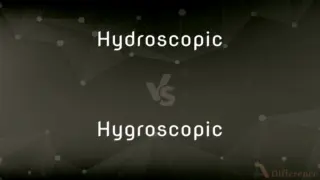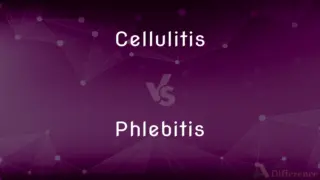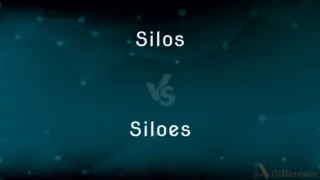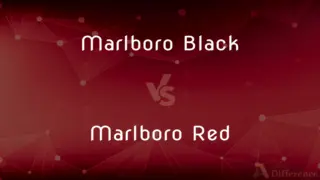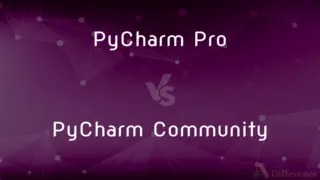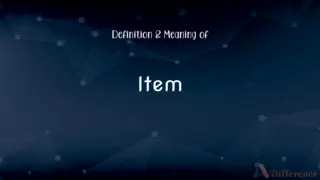Disodium EDTA vs. Tetrasodium EDTA — What's the Difference?
By Tayyaba Rehman — Published on December 14, 2023
Disodium EDTA has two sodium ions; Tetrasodium EDTA has four sodium ions.

Difference Between Disodium EDTA and Tetrasodium EDTA
Table of Contents
ADVERTISEMENT
Key Differences
Disodium EDTA and Tetrasodium EDTA are both chelating agents used in various products. While both serve similar purposes in binding metal ions, their chemical structures differ. Disodium EDTA contains two sodium atoms, while Tetrasodium EDTA possesses four.
In cosmetics and personal care products, both Disodium EDTA and Tetrasodium EDTA are used to maintain product stability and prevent deterioration. Disodium EDTA is often chosen for its ability to enhance the foaming and cleaning capabilities of certain products, whereas Tetrasodium EDTA might be used for its higher ion-binding capacity.
When we look at the chemical formula, the distinction between Disodium EDTA and Tetrasodium EDTA becomes clearer. The "di" in Disodium EDTA indicates the presence of two sodium ions, while the "tetra" in Tetrasodium EDTA denotes four sodium ions.
As a result of their different sodium ion content, Disodium EDTA and Tetrasodium EDTA might exhibit varied solubility in water. This distinction might affect the choice of one over the other depending on the specific formulation requirements of a product.
In terms of applications, while both Disodium EDTA and Tetrasodium EDTA can be found in skincare, haircare, and other consumer products, the choice between them is often dictated by the specific needs of the product formula, considering factors like pH stability and desired consistency.
ADVERTISEMENT
Comparison Chart
Sodium Ion Count
Contains two sodium ions
Contains four sodium ions
Common Use
Enhances foaming and cleaning
Higher ion-binding capacity
Solubility
Varies, but generally good in water
Typically high solubility in water
PH Stability
Preferred for certain pH ranges
Might be stable in different pH ranges
Presence in Products
Common in skincare and haircare
Found across various product types
Compare with Definitions
Disodium EDTA
An agent that binds metal ions.
Disodium EDTA helps prevent metals from affecting product quality.
Tetrasodium EDTA
A common ingredient in various consumer products.
Tetrasodium EDTA can be found in many lotions and cleansers.
Disodium EDTA
A chemical compound used as a chelating agent.
Disodium EDTA is added to shampoos to improve their stability.
Tetrasodium EDTA
An effective stabilizer and preservative.
Tetrasodium EDTA enhances the longevity of certain beverages.
Disodium EDTA
A molecule with two sodium ions.
The di in Disodium EDTA refers to its two sodium atoms.
Tetrasodium EDTA
A compound known for its ability to sequester metal ions.
Tetrasodium EDTA is widely used in skincare products.
Disodium EDTA
A preservative in many cosmetic products.
Check the ingredient list; you might find Disodium EDTA.
Tetrasodium EDTA
A chelating agent with four sodium ions.
Tetrasodium EDTA has a stronger ion-binding capacity than its disodium counterpart.
Disodium EDTA
A stabilizer in some food items.
Disodium EDTA can be found in certain dressings to prolong shelf life.
Tetrasodium EDTA
A protector against metal ion-induced deterioration.
Tetrasodium EDTA prevents metallic discoloration in some products.
Common Curiosities
Is Disodium EDTA safe in cosmetics?
Disodium EDTA is deemed safe in cosmetics when used in appropriate concentrations.
What is Disodium EDTA used for?
Disodium EDTA is used as a chelating agent in various products, binding metal ions to prevent deterioration.
How does Tetrasodium EDTA differ from Disodium EDTA?
Tetrasodium EDTA has four sodium ions, while Disodium EDTA has two.
Why is Tetrasodium EDTA added to skincare products?
Tetrasodium EDTA enhances product stability by binding metal ions.
Do both compounds serve the same purpose?
Both Disodium EDTA and Tetrasodium EDTA are chelating agents, but their specific applications can vary.
Are there any concerns regarding their use?
Both compounds are considered safe in regulated amounts, but it's always best to check product labels and consult experts.
Is Tetrasodium EDTA more potent than Disodium EDTA?
Tetrasodium EDTA has a higher ion-binding capacity due to its four sodium ions.
How are they produced?
Both Disodium EDTA and Tetrasodium EDTA are synthetically produced in laboratories.
Can I find them in my everyday products?
Yes, both Disodium EDTA and Tetrasodium EDTA are commonly found in skincare, haircare, and other consumer products.
Do they have environmental concerns?
Some concerns exist regarding their biodegradability, but research is ongoing.
How do you identify the number of sodium ions in these compounds?
"Di" in Disodium EDTA indicates two sodium ions, and "tetra" in Tetrasodium EDTA indicates four.
Can Disodium EDTA be found in food?
Yes, Disodium EDTA is sometimes used as a stabilizer in certain food items.
Are they both water-soluble?
Both Disodium EDTA and Tetrasodium EDTA are generally water-soluble, but their solubility can vary.
Do they affect product pH?
Both can influence product pH, and the choice between them may depend on specific pH stability requirements.
Why are they important in cosmetics?
Disodium EDTA and Tetrasodium EDTA prevent metal-induced deterioration, enhancing product shelf life and quality.
Share Your Discovery

Previous Comparison
Open Syllable vs. Closed Syllable
Next Comparison
1 Butanol vs. 2 ButanolAuthor Spotlight
Written by
Tayyaba RehmanTayyaba Rehman is a distinguished writer, currently serving as a primary contributor to askdifference.com. As a researcher in semantics and etymology, Tayyaba's passion for the complexity of languages and their distinctions has found a perfect home on the platform. Tayyaba delves into the intricacies of language, distinguishing between commonly confused words and phrases, thereby providing clarity for readers worldwide.







